What if there was a way to design your product so it essentially promotes itself?
You’ve heard of the traditional acquisition funnel., The most common approach for growth is to build a great product, test multiple marketing channels and tactics, then optimize towards those top-performing strategies. This approach is straight out of Marketing 101. However, at one or point another, your growth will plateau and your strategy will stop delivering desired results. Simply put, it’s not sustainable.
Enter growth loops. Growth loops provide a highly efficient way to grow your brand and create a product that essentially promotes itself. While growth loops are not “new,” they haven’t been widely taught as a way for brands to grow. However, without growth loops, brands like TikTok and Apple wouldn’t have achieved their growth today. This is the secret growth strategy Fortune 500 brands have been using to drive billions in revenue and how they’re doing it.
Learn immediate strategies to optimize your existing acquisition funnel
What are Growth Loops?
In short, growth loops are self-reinforcing actions, or loop cycles, built into a product or service which garner a desired growth output. Sounds complicated, however it’s much more simple than you may think. Let’s look at this concept as defined by growth expert, Brian Balfour:
“Loops are closed systems where the inputs through some process generates more of an output that can be reinvested in the input. There are growth loops that serve different value creation including new users, returning users, defensibility, or efficiency.”
Example of a growth loop:

What he’s describing is a system where you can leverage your existing user base and their engagement to ensure your product or service is consistently exposed to a new audience at no additional costs; a.k.a. the future of growth marketing.
This is the power of growth loops and the industry standard and model that we use and have incorporated for our own systems of growth.
Traditional Funnel Framework
The model that most growth marketers have been utilizing for the last 10+ years is commonly known as the Pirate Funnel (named because the acronym of each step spells out “AAARRR”).
Example of a Pirate Funnel:
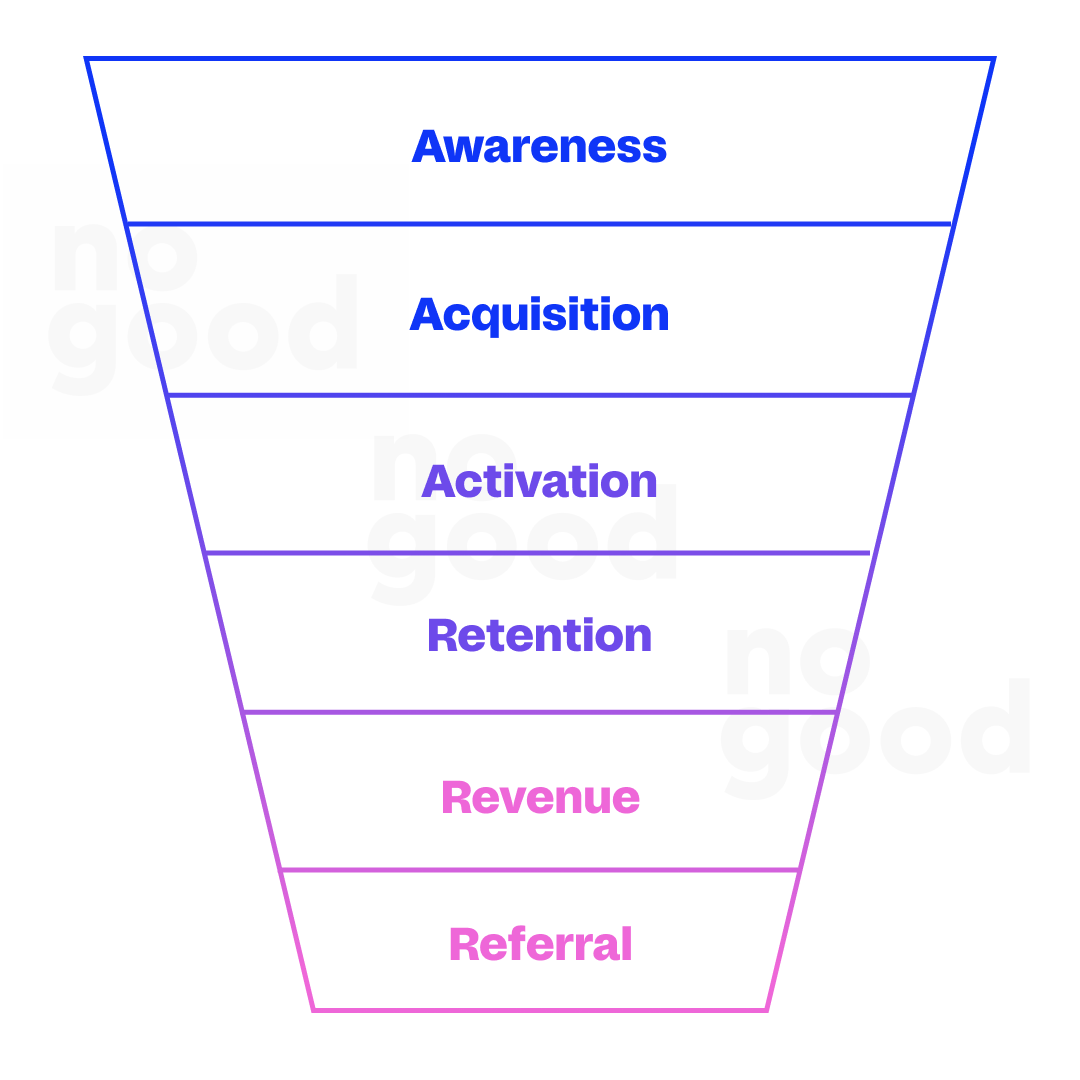
- Awareness – how are you building your brand and getting in front of potential customers?
- Acquisition – how are you getting users to engage with your brand and getting permission to message them going forward?
- Activation – how are you getting users to take their first significant action (sign up for a free trial, download an app, etc.)?
- Retention – how are you getting users to come back to your product or service?
- Revenue – how are you closing sales, and how can you upsell?
- Referral – how are you convincing users to invite their friends to try your product or service?
This funnel is a solid framework for marketers to get started when devising their strategy, as it keeps focus on the metrics that drive business. Each step has its own metrics of success, and today’s marketers have more than enough data to determine where their process needs refining.
When viewed as a linear growth process, data-driven marketers can easily see where bottlenecks are in the user journey, and work to optimize those areas.
Issues With the Traditional Funnel
Unfortunately, this dated funnel model has the unintended consequence of creating silos among departments, where marketing owns growth, product owns retention, and sales owns revenue, and so on. With these different areas of ownership, each department also has its own KPIs. However, without perfect alignment, these departments often find themselves competing against each other, where success in one metric/step in the funnel can be detrimental to another.
For example, let’s say that a business ran a funnel analysis and saw that the bottom-funnel metrics were converting well. This means in order to grow, marketing was responsible for driving more leads. With that as their primary KPI, they’d implement strategies to drive up that number, but would most likely bring in low-quality leads. This in turn tanks the bottom-funnel metrics. Similar to a game of Whack-A-Mole, now it’s up to product or sales to modify their strategy to increase the conversion rate.
The other issue with this funnel is it’s one directional. Even in a perfect world where all departments are aligned, the only path to growth is to pour more into the top of the funnel – money, tactics, channels, etc. – all while knowing the majority of users won’t make it all the way through. This strategy is simply unsustainable.
Growth Loops VS Funnel Framework
Growth loops solve the sustainability problem in two ways.
First, growth loops are like the compound interest of marketing. Instead of continually pouring more resources into the top of the funnel to increase the output at the bottom, the product is designed to grow itself as more users convert. The more users you have, the more users are brought in. This exponential growth also doesn’t require additional costs each time you want to expand brand awareness. This means it’s more sustainable from a cost perspective.
Additionally, since growth loops are built into the product, they’re harder for another brand to replicate. This is because the loop, in many ways, is custom to your product. It’s pretty easy for a competitor brand to replicate an advertising tactic. This will either result in increased costs or decreased effectiveness. It’s much more difficult for a brand to redesign its product in the exact way your loops are built. In the long run, this makes your growth loops a much more sustainable strategy for growth.
Introducing the Acquisition Growth Loop
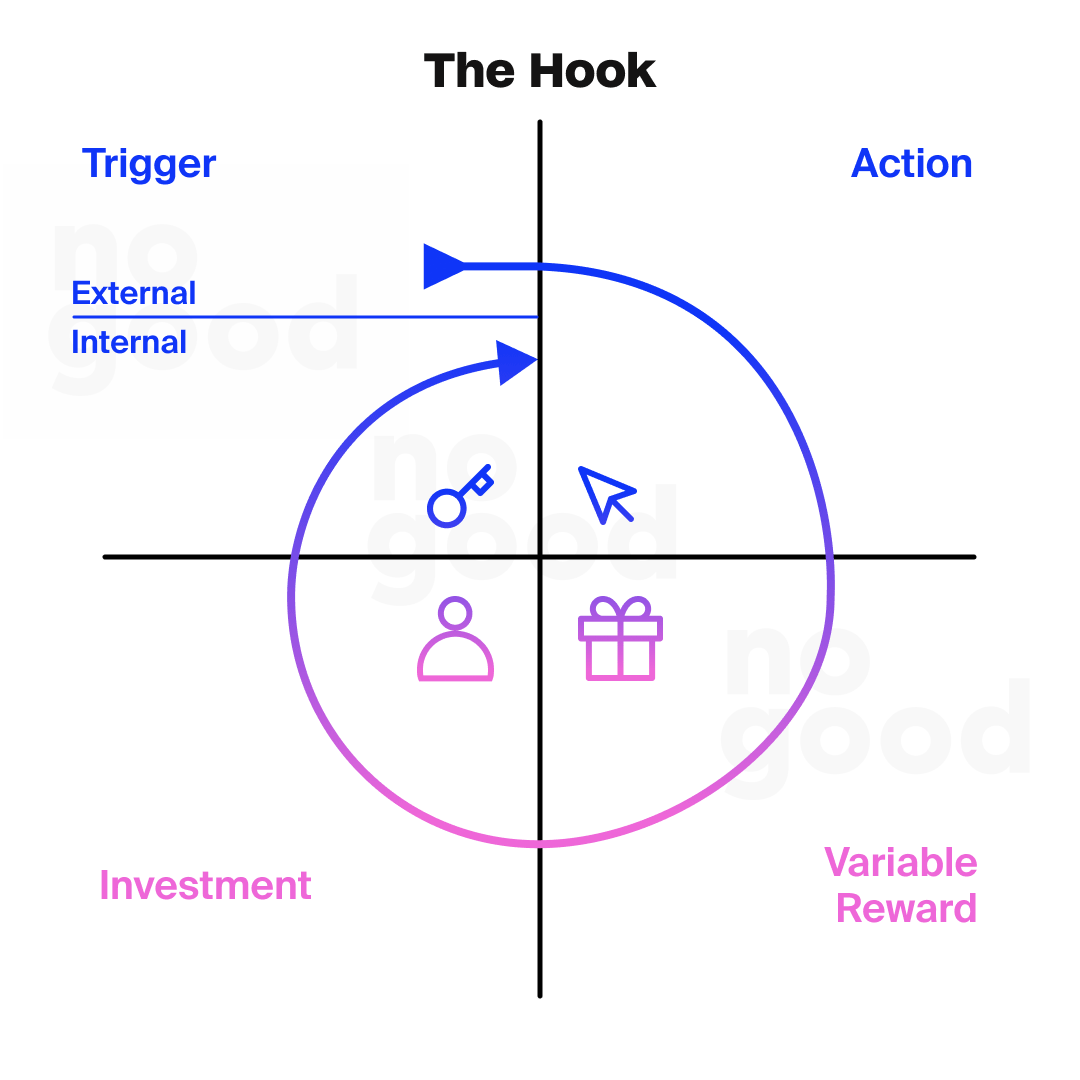
As we mentioned before, the concept of creating growth loops for your customers isn’t entirely new, especially if you’re familiar with Nir Eyal’s “Hooked” model. He outlines a four step process for a company to build a habit-forming product that brings users back again and again, without relying on additional marketing or messaging.
- Trigger – an internal or external cue that prompts the user to take action
- Action – the simplest behavior in anticipation of a reward
- Variable Reward – sustain user interest by satisfying their needs while leaving them wanting to re-engage with the product
- Investment – the anticipation of rewards in the future
Now, there are some differences between growth loops and the hook model. The former is a strategy to bring in new users. The latter is a strategy to ensure existing users keep using your product. On the other hand, there are many similarities with regards to engineering an intended response from understanding user signs.
Eyal’s “trigger” mirrors the initial input of a growth loop, as both are the first step in getting a user engaged and driving them towards an intended action. The “action” step is also pretty similar; in both cases, you want to encourage the desired behavior. To execute this, the product must be designed so that it’s clear what the user is supposed to do next, it’s easy to complete, and the user is properly motivated to do so.
Where they differ is after the action step. The growth loop requires an external action designed to expose the brand to potential new users. In contrast, the Hooked model is an internal action designed to establish a habit.
However, these two loops can both exist within the same product because of these variances in end goals. A hook to ensure your product becomes part of a consumer’s daily habit, and a growth loop to ensure that your existing users are helping you to grow, allowing the user to reinvest the output of one cycle to the next.
Driving consistent engagement and growth without investing additional resources is a recipe for explosive growth.
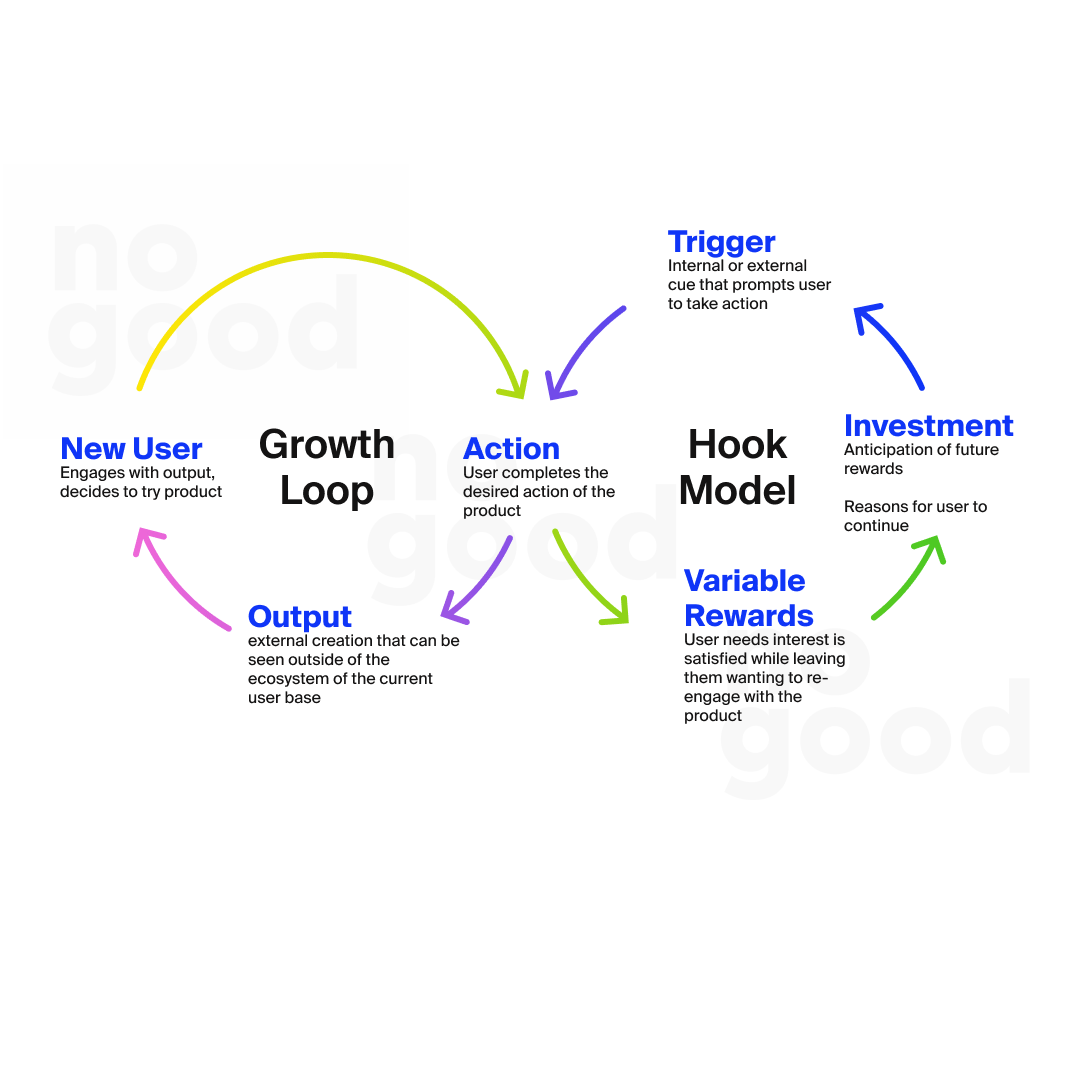
Types of Growth Loops
Word of Mouth Growth Loop
In its simplest form, word of mouth is probably the most simple growth loop. You create an awesome product, introduce it to your audience, they love it, and tell their friends about it.
However, while this is great when it happens, as growth marketers, we’re focused more on areas where we can control. Relying only on word of mouth to grow your brand is unreliable, unpredictable, and can’t really be measured. Creating a growth loop is more about how to engineer your product so you can test and know these loops will happen.
Referral Program Growth Loop
Referral programs can be considered a growth loop as well. Countless companies have leveraged this tactic, typically offering users some kind of bonus for referring their friends. Examples of this include how Dropbox famously offers additional storage space for referrals, or Tesla’s referral program, where new and existing users earn credits from referring new customers and making purchases, so they can then spend those credits on more Tesla merchandise.
However, replicable tactics seem to have a shelf life of effectiveness. Once brands start to notice something working for another brand, they’ll attempt to use it for their own product, and as users begin to see the same strategy repeatedly, it starts to lose its effectiveness.
Growth marketers need to be agile. There needs to be a deep understanding of who is using their product, how they are using it, and how all of that can be leveraged in a way that’s specific to the business.
For example, without relying on paid advertising, TikTok is the fastest growing platform on the planet right now with over 3 Billion global downloads. Their users are also highly engaged, with the average user spending 95 minutes/day in the app. They were able to achieve this by leveraging their own users to get the word out themselves, and creating hooks to keep their audience consistently returning to the platform. TikTok is the master of word of mouth growth loops.
TikTok Growth Loop:
- The user sees viral TikTok content and is driven to download the app.
- The user opens TikTok, sees the latest viral challenge, and creates content to join the community.
- This content is sent out to the TikTok community, and easily findable/sortable via specific hashtags.
- Content is downloaded off the app (a feature made intentionally by TikTok) and re-packaged into YouTube compilations where it’s more accessible to non-TikTok users. New users watch and enjoy the content and want to see what TikTok is all about and download it.
TikTok Hooked Model:
- Trigger – TikTok’s external trigger is its viral content that engages new users. Once they’re signed up, similar to many social networks, the internal triggers are often boredom or social validation.
- Action – TikTok’s desired action is for the user to create and post a video, which they make not only easy, but fun, with a wide variety of music, filters, and other effects that allow the user to be as creative as possible.
- Variable Reward – For viewers, the variable reward is the constant mix of different content that starts playing as soon as the app is opened. For creators, the variable reward is the alluring desire to make videos that get the most views, likes, and comments.
- Investment – While anyone can download the app and watch videos, an account needs to be made to follow friends or popular creators. In doing so, their feed becomes more customized to the viewers’ preferences, keeping them hooked on the content. For creators, the content they create allows them to build a reputation and fan base on the platform, which will make them a lot more likely to continue using TikTok.
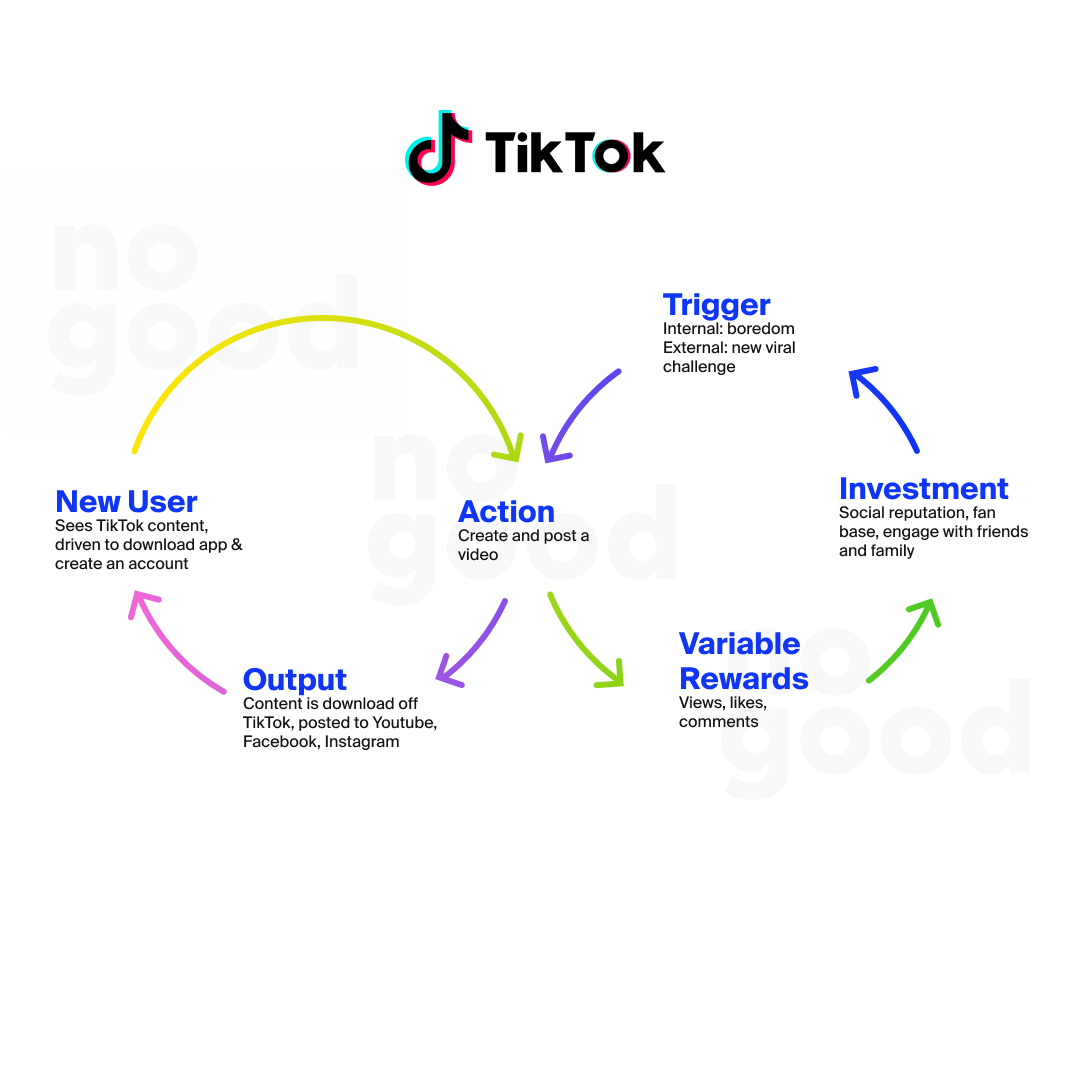
Apple’s iPhone is another excellent example of a company leveraging the power of growth loops and a hook model. This grows new iPhone users and keeps current ones upgrading every year.
iPhone Growth Loop:
- New users hear about the new iPhone through word of mouth, Apple’s WWDC Conference, or from other Apple users
- Users then purchase the new iPhone through their carriers or Apple’s exclusive iPhone trade-in program.
- They share their experience with others through word of mouth or on social media, creating temptation and desire for the product.
iPhone Hooked Model:
- Trigger – iPhone’s external and internal triggers stem from an existing user’s desire to have the newest products or features that everyone else has. Internally wanting these new features, and Externally using or seeing other people use them.
- Action – User makes a decision to purchase the new iPhone
- Variable Reward – They are then rewarded with an exclusive color, feature, like a new camera, or influence by having the new iPhone.
- Investment – Users will then purchase more Apple products (like the Apple Watch) or invest in services, like Apple Music or iMessage, that will pair well with their new iPhone, and make them long term users.
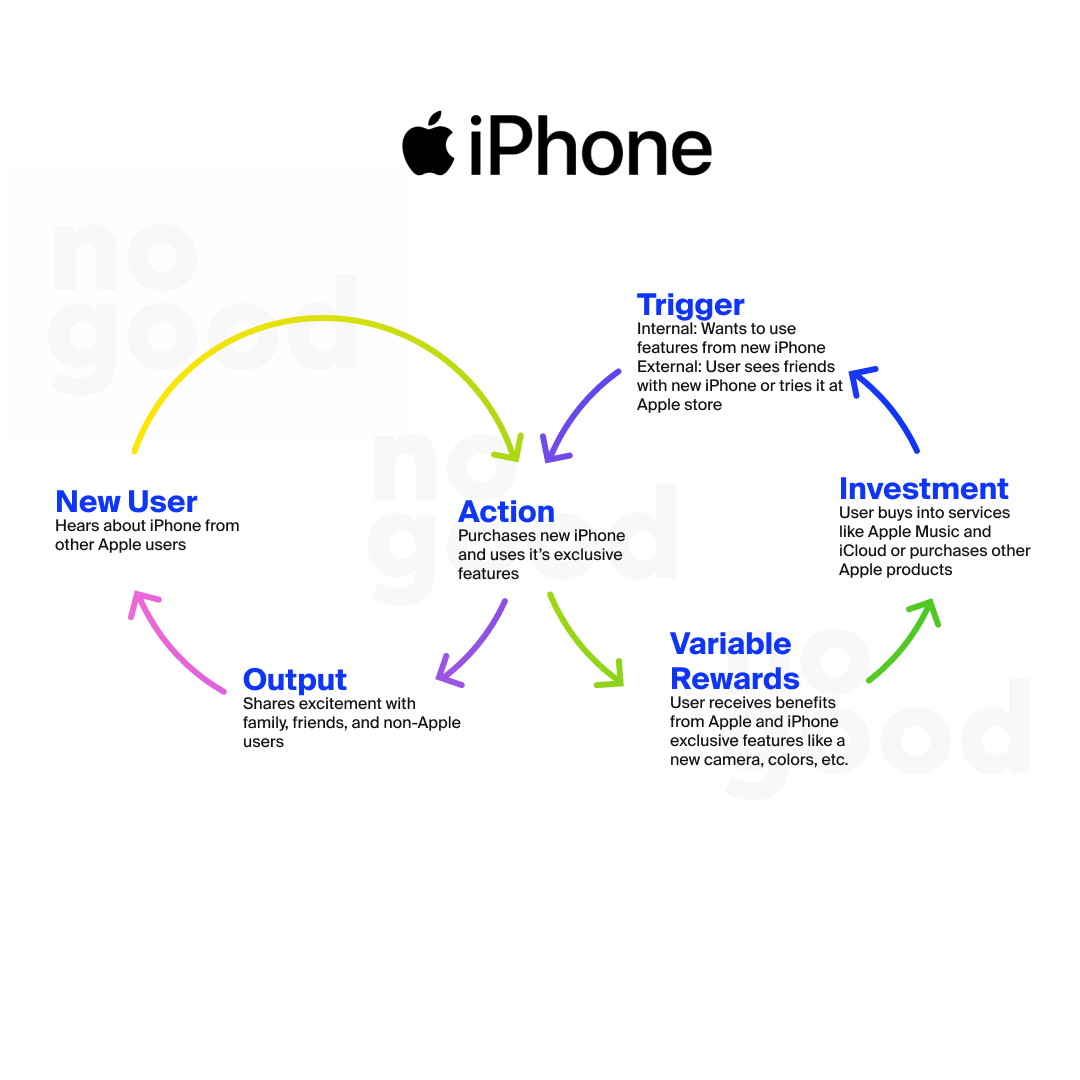
What Products/Brands Are Growth Loops Right For?
The growth loop model is still relatively new, so it will continue to evolve and become more refined as marketers learn and test. As of now, there seem to be three areas for loops to have the biggest impact.
- Businesses where the output is User Generated Content. As we’ve seen with the rise of social media, people have an innate desire for social rewards and connectedness. If you invest time to create something, you’re going to want to be rewarded for your effort somehow, meaning you’re going to want to share your creation. This ensures that for each new user your product gains, the more people will see their output, thus restarting the loop.
- Businesses with a network effect. The network effect occurs when increasing the number of people or participants will improve the value of a good or service. A platform like Facebook doesn’t mean much if you’re the only one with a profile, but if all of your friends and family use it as well, it becomes a much more valuable communication tool. This effect can also be seen with B2B products like Slack. Suppose Slack is your preferred method of business communication. In that case, you’ll become an unofficial ambassador for the brand, because everyone that wants/needs to communicate with you will need to download Slack as well, thus restarting the loop without any investment on the part of Slack.
- Businesses following community-led growth. Brands that deploy community-led growth as part of their growth strategy are sure to benefit from growth loops due to the natural process of the users and consumers that are already advocating for them through word-of-mouth, contributions (think: Notion and user-generated templates) and referrals. That community will speak volumes for the brand to new and existing users, causing a viral growth loop built on retaining and converting users. These growth loops rely on existing users feeding the loop with content, reviews, and support to convert or retain users for that brand and can even help with search engine optimization (SEO) as well.
Find out if the growth loop model is right for your brand
How to Implement Growth Loops Today
- Ask each department in your company, “How does our product grow?”
- Align on a high-level consumer journey map
- Identify your points of leverage
- Define the most important metrics
- Revise your overall marketing strategy to align
To get started, Brian Balfour recommends a simple exercise: go around your company and ask five different people (ideally you’ll have representation across product, marketing, sales, and management) to draw a visual picture to answer a seemingly simple question.
How does our product grow?
While this seems like a simple question, the results typically aren’t totally aligned. Answers will often differ or show only a small piece of the puzzle. This can also be a significant problem for a business. If internal priorities aren’t in sync, how can there be an apples-to-apples discussion on strategy, metrics, priorities, or even what success looks like?
First and foremost, this audit should serve as a wake-up call to the importance of growth loops. The overall goal of this discussion is to get everyone aligned on a high-level consumer journey map.
The next step is to identify what Balfour calls your “point(s) of leverage.” What are the most impactful areas of that map? What can be improved that could have the most significant impact?
Once these are identified, you’ll be able to recognize the money and resources going towards initiatives outside your point of leverage. Then you should look towards defining the most important metrics and revising overall strategy.
It’s also worth noting that these can change over time, so it’s essential to review the above exercises and questions regularly. The first review may result in a new roadmap. After implementation, there will undoubtedly be more learnings as a result, so maybe the map needs another revision. But no matter what, the takeaways from these audits should be both actionable and measurable.
As with all things in marketing, review the data, and optimize constantly. If you follow the steps above with a deep understanding of how and why to create growth loops, you’ll be on your way to real, sustainable growth.
Let us help you drive growth and build a self-promoting product







I always wondered how loops were different or better than the traditional funnel. Thanks for the article.
Great content and graphs. thanks for sharing
Hands down the best article on growth and acquisition loops. Thank you for the effort.
I love how you brought these 2 growth frameworks together into 1 synthesis. Clearly explained; interesting examples and a relevant CTA to get the perspectives on growth aligned within your own company. Thank you!